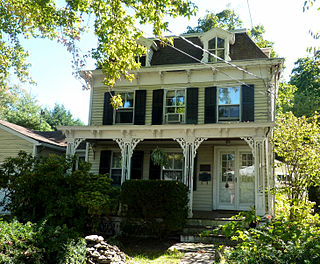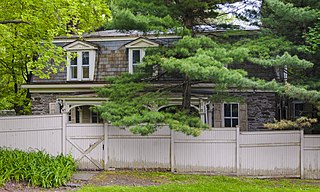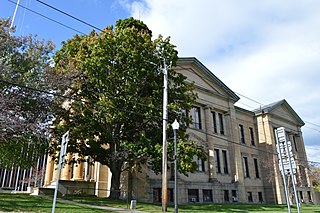
Porter Sheldon was an American politician and a U.S. Representative from New York.

Vanderbeck House, also known as the Daughters of the American Revolution Chapter House, is a historic home located at Rochester in Monroe County, New York. It is a three-story brick structure with a slate-covered mansard roof and a foundation of sandstone blocks. It was built in 1874 in the Second Empire style. In 1959, the single family home was converted to offices and apartments.

Lewis House is a historic home located at Cape Vincent in Jefferson County, New York. It was built about 1875 and is a modest, eclectic 1 1⁄2-story frame house with an attached 3 1⁄2-story tower and a 1-story side wing with a shed roof. The tower is in the Second Empire style with a distinctive mansard roof.

Thomas Richardson House is a historic home located at Ilion in Herkimer County, New York. It was built about 1873 is a brick structure with an asymmetrical rectangular plan in the Italianate style. The two-story main block has a hipped roof and 3 two-story projecting bays with clipped gable roofs covered in slate. It features a three-story tower with a two-tiered, concave mansard roof. The property includes the original carriage house and landscaping.

House at 205 North Main Street is a historic home located at Canastota in Madison County, New York. It was built about 1870 in a small scale, eclectic adaptation of the Second Empire style. The one story structure features a multi-gabled, flared mansard roof with polychrome slate shingles.

Charles M. Weeks House is a historic home located at Huntington in Suffolk County, New York. It is a 2 1⁄2-story, clapboard residence with a mansard roof. It was built about 1860 and representative of the Second Empire style. It has a 2-story shed-roofed kitchen wing. Also on the property is a barn built about 1900.

The Charles Homer Davis House is a historic house located at 381 West Neck Road in Lloyd Harbor, Suffolk County, New York.

Carson McCullers House is a historic home located at South Nyack in Rockland County, New York. It is a two-story Second Empire–style residence constructed in 1880 and modified with subsequent interior and exterior modifications largely in the Colonial Revival spirit about 1910. It is a frame structure built originally as parsonage, three bays wide and four bays deep. It features a one-story verandah, a slate-covered mansard roof, and an interesting multi-story tower projection crowned by a bell-cast roof. It was home to noted author Carson McCullers (1917–1967) from 1945 to 1967.

Henry M. Peck House was a historic home located at West Haverstraw in Rockland County, New York. It was built about 1865 and is a large two-story, wood-frame dwelling on a stone foundation. It featured an S-curved mansard roof sheathed in slate in the Second Empire style. It also had a central projecting entrance / tower bay and two-story gable-roofed kitchen / servant wing.

Parry House is a historic home located at Highland Falls in Orange County, New York. It was built about 1860 and is a two-story frame dwelling on a brick foundation. It features a slate mansard roof with concave or bell cast sides in the Second Empire style.

The Squirrels is a historic estate located at Highland Falls in Orange County, New York. It was built about 1845 and is a two-story frame and clapboard structure with a multi-gabled roof. A two-story frame wing was added to the original farmhouse about 1856 and the house redesigned by architect Calvert Vaux. Also on the property is a one-story gatehouse with a mansard roof. The estate was owned and the house expanded by John Bigelow (1817–1911).

W. W. Hartwell House & Dependencies, also known as Regina Maria Retreat House, is a historic home located at Plattsburgh in Clinton County, New York. It was built about 1870 and is an elaborate stone mansion featuring a three-story tower with a Mansard roof in the Second Empire style. The house is set among park-like landscaping. Also on the property are a cottage and a stone carriage house.

Walrath-Van Horne House is a historic home located at Nelliston in Montgomery County, New York. It was built in 1842 and was originally a 1 1⁄2-story Greek Revival stone house with a full-height portico. In 1895, a frame, shingled second story topped by a Mansard roof and new porch with mansard styling replaced the original. The house retains some Greek Revival interior styling, but the exterior has a Second Empire style.

Zopher Delong House is a historic home located at Glens Falls, Warren County, New York, United States. It was built about 1870 and is a 2 1⁄2-story, three-bay brick residence with a frame service wing. It has Italianate- and Second Empire–style design elements, including a mansard roof. It features a 2-story central pavilion and bracketed entrance portico. Also on the property is the original carriage house. It is maintained as a historic house museum known as the Chapman Historical Museum by the Glens Falls-Queensbury Historical Association.

F. W. Wait House is a historic home located at Glens Falls, Warren County, New York. It was built about 1876 and is a rectangular, 2 1⁄2-story, brick residence with a slate mansard roof in a transitional Italianate / Second Empire style. It retains many of its original decorative details.

Gardner House is a historic home located at Guilderland in Albany County, New York. It was built about 1875 and is a two-story Second Empire style farmhouse with a mansard roof and dormers. It features a one-story porch with carved and sawn brackets. Also on the property is a smoke house.

Springwood Manor is a historic home located at Loudonville in Albany County, New York. It was originally built about 1890 and is a 2 1⁄2-story, five-bay, masonry dwelling with a mansard roof. It was extensively remodeled in 1912 in the Colonial Revival style. Also on the property are a barn, carriage house, shed, and gardens with a spring fed pond.

House at 362 Sea Cliff Avenue is a historic home located at Sea Cliff in Nassau County, New York. It was built about 1875 and expanded in 1890. It consists of a three-bay, 2-story main section with a mansard roof and 1 1⁄2-story gable-roofed wing in the Second Empire style. It features a shed-roofed porch with scrollsawn corner brackets.

Mapleton, also known as Alumnae House, College of White Plains, is a historic home located at White Plains, Westchester County, New York. It was built in 1867 and is a large, 2 1⁄2-story five-bay residence with Second Empire and Italianate-style design details. It features a large verandah, a central pavilion tower capped with a small dome, and a mansard roof with slate tiles. Also on the property is a polygonal frame gazebo. From 1894 to 1925, it housed the convent of the Sisters of the Divine Compassion. In 1925, the house was acquired for academic use. It was owned by the College of White Plains, which merged with Pace University in 1976.

The Jan Pier House is a historic home located at Rhinebeck, Dutchess County, New York. The farmhouse was originally built about 1761 and remodeled about 1881 in a Second Empire style. It is a one- to two story, asymmetrical stone building built into a hillside. It features a Mansard roof sheathed in polychrome slate. Also on the property are two contributing barns, a smoke house, wellhouse / well, and a cistern.






















